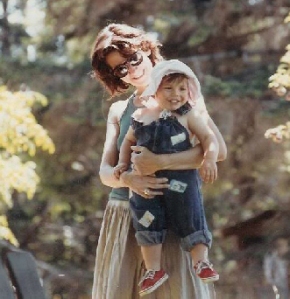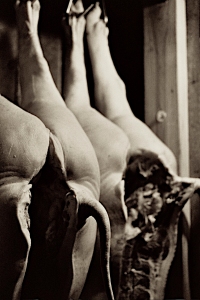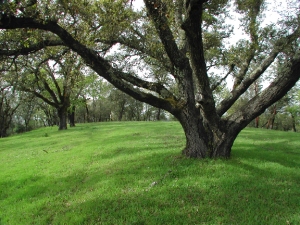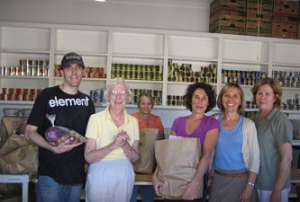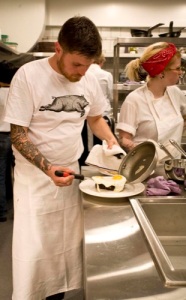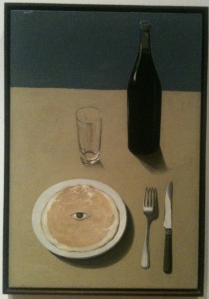(originally posted April 28, 2010)
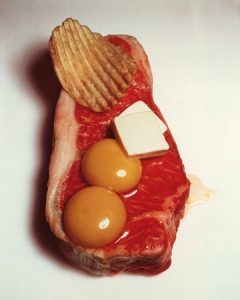
The mid-60’s were pretty heady times to grow up in LA, especially for a teenager on the prowl with a fake ID and somebody’s parents borrowed car. You could catch Buffalo Springfield at the Roxy, the Byrds at the Whiskey, with drinks caged at Ciro’s between sets. The world was already starting to go to hell in a handbag, but if you drove down Sunset to the beach to watch dawn break over Santa Monica Bay, youth and the hubris that goes with it softened any nagging doubts a night of great rock 'n roll hadn’t already swept away. And then there was Norm's. Doris’ section at Norm's coffee shop on La Cienega Blvd to be precise, where, for the incredible sum of 99 cents, you could feast on steak, two eggs any style, toast, jam, and unlimited mugs of coffee. 99 cents. 24 hours a day. 7 days a week.
Norm's wasn’t just stoner heaven ~ it was trucker heaven, housewife with screaming children heaven, bus driver and cop on their way to work heaven. No one asked where the beef came from, much less how it had been raised or slaughtered. The endless cups of coffee came out of a metal jug that sat on a warmer, not French pressed from fair trade organic beans. The jams were luridly colored, and, except for a stray seed, you couldn’t tell wheat toast from rye. But hot damn did it all taste good. There was no greater way to spend an early Sunday morning the year I was 16 than to sit in a warm vinyl booth with my best friends, stuffing our faces and laughing hysterically about our antics of the night before. Warm, hospitable, it was actually a meal that hit all the flavor profiles we aspire to serve at the restaurant today ~ salty, sweet, and bitter, all wrapped up in a big umami bow.
Excavating and analyzing significant food memories is quite the pastime around here, as I would guess it is throughout foodie enclaves across the country. And I bet I’m not the only one whose noteworthy food recollections were born in a cheap diner, not some Platonic ideal universe filled with grass fed beef and biodynamic vegetables grown from heirloom seeds.

My personal journey from Norm's to owning a farm to table restaurant in the heart of one of the most extraordinary food sheds in the world started with a baby. He was bald, enchanting, and utterly gorgeous, the most life-affirming creature I’d ever seen. From the day he arrived I went from not paying much attention to what I ate to considering every spoonful ~ simply because the food I put into my body was going to end up in his body too. By his second birthday I was president of one of the largest food co-ops in the country, fighting to establish national organic laws. Four years after he was born, with his little brother in tow, we stuck our first spade in the ground 600 miles away in a rural community where I was a virtual stranger. To quote John Lennon, it was a life that happened while I busy making other plans.
The food I subsisted on before my “conversion” was no doubt the cheap product of large food concerns, but it was still real food. For that Norm’s 99er, the steer and the cow that provided the steak, the milk, and the butter had not been unnecessarily treated with antibiotics. The wheat in the bread and the corn syrup in the jam did not come from genetically modified seeds. The chickens who laid the eggs didn’t have to play a trap door guessing game ~ where if they didn’t figure out which flat panel in the enormous coop was actually a door to the outside within the first weeks of their life meant they were doomed to be stuck inside it until they died.
It’s increasingly hard to know where to begin a discussion of what’s gone wrong with food production since then.
*Do you start with busting the myth of the green revolution that told us that only through genetically modified foods we could help feed a starving world?
*Do you question the logic behind dousing the animals we eat with massive amounts of antibiotics, thus rendering those drugs less effective to fight new mutant strains overuse of them has created?
*Do you challenge the morality of not giving the animals that feed us healthy lives and a good death?
*Do you throw common sense at an agribusiness numbers game that bases profitability on the amount produced per crop, not the nutrition produced per plant?
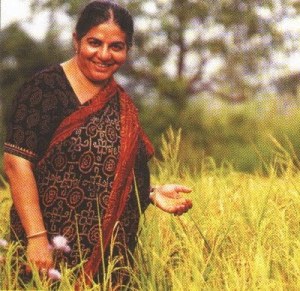
A few years ago I was fortunate to meet Vandana Shiva when she spoke at Sonoma Country Day School, part of a wonderful series the intrepid Cindy Daniels created to bring passionate educators to our community. Vandana came to dinner at Barndiva after the talk and great skeptic though I am, (another throwback of growing up in Hollywoodland) I had the sense that I was in the presence of a great woman: that I’d better listen up and listen good. If you haven’t ever heard Vandana speak, through the wonders of the internet you can do so. I urge you to do so.
Vandana fights causes in many arenas but none are closer to her heart than the global threat to the seed. Her case, simply put, is this: A seed is not an invention that should be patented. A seed renews, multiplies, spreads, and is shared. It is the essence of life, and belongs to civilization, to history, not to agribusiness, as their property to be sold, and thus controlled.

Yet that is just what is happening today. Using something called The Trade Relationship Intellectual Property Protection Agreement (TRIPP), Pioneer Hi-Bred, Monsanto, Novartis and a handful of other powerful agribusiness corporations have, in the last two decades, laid claim in the form of “patents” to thousands upon thousands ~ some say nearing 80% ~ of open seed varieties in the world today. These are seeds that throughout history farmers have traditionally saved and replanted to feed humanity. Yeah, that’s a Trip all right.
But here’s the best (read: worst) part. The battles being waged in the International Court of Justice in The Hague on the veracity of any “agreement” made between governments and corporations which can affect the human race’s ability to feed itself, even if they are won, will come too late to stop what is going on. By controlling and diminishing the use of wild seeds in third world countries, companies like Monsanto have already ensured the predominance of their own Genetically Modified products. It's hard to fathom the morality of a mindset that seeks to make money out of killing the essential nature of the seed to reproduce, but this is their endgame, make no mistake.
As Vandana succinctly explains ~ when one (wild seed) gives rise to many, there is no money to be made. But when one (GM seed) gives rise to nothing, there is a great deal of money to be made ~ when you control the rights to that seed. He who controls seeds, controls what is grown. A farmer that cannot use gathered seeds to regenerate crops is forced to buy whatever seeds are on the market. And whatever chemicals ~ which in the case of bioengineered seeds is a lot ~ needed to sustain them.

The writing is on the wall. In the Punjab region of India, a third world test case for the so called green revolution, when GT cotton ~ sold to farmers with the promise it would increase productivity tenfold ~ was planted, in one decade it all but destroyed the fecundity of a valley that had been naturally farmed for 5,000 years. 8 million farmers lost their livelihoods in that government assisted debacle, partly as the result of chemical dependence they could not afford. Where traditional bio diverse farming techniques once provided alternatives, when their monoculture crops failed, they left only depleted soils behind. If Vandana is to be believed, and believe her I do, 200,000 Indians farmers in this region committed suicide as a direct result of the GT cotton experiment. Many died by drinking Monsanto Round-Up as a final wake up call to the world.
Yet the world slumbers on.
If you want to wake up, there are still things you can do.
For a start, click on the links below.
The link Food Democracy Now will let you voice your concern on a very important, time sensitive issue about GMO labeling. Stand Up for Your Right to Know!
Food Democracy Now
Organic Consumers Association
Huffington Post
Navdanya
Oregon Tilth
Tierra Vegetables

All text and photos, Jil Hales (unless otherwise noted)

 The Barndiva Lounge and the Gallery Diningroom were overflowing with Dragonfly roses, knowing looks, delightful banter and genuinely smiling faces.
The Barndiva Lounge and the Gallery Diningroom were overflowing with Dragonfly roses, knowing looks, delightful banter and genuinely smiling faces.
 Thank you for entrusting us with your Mother's Day celebration.
Thank you for entrusting us with your Mother's Day celebration.






